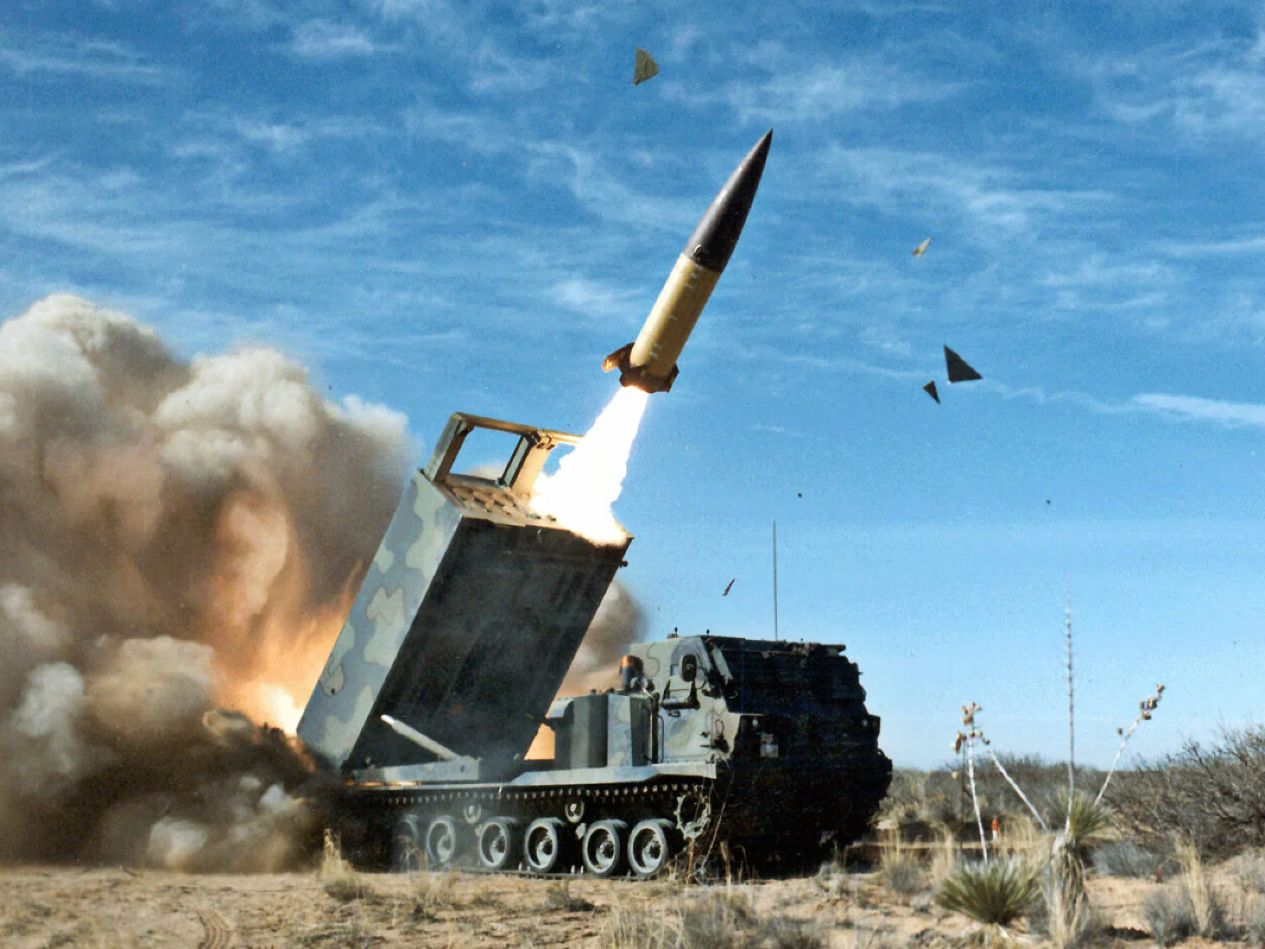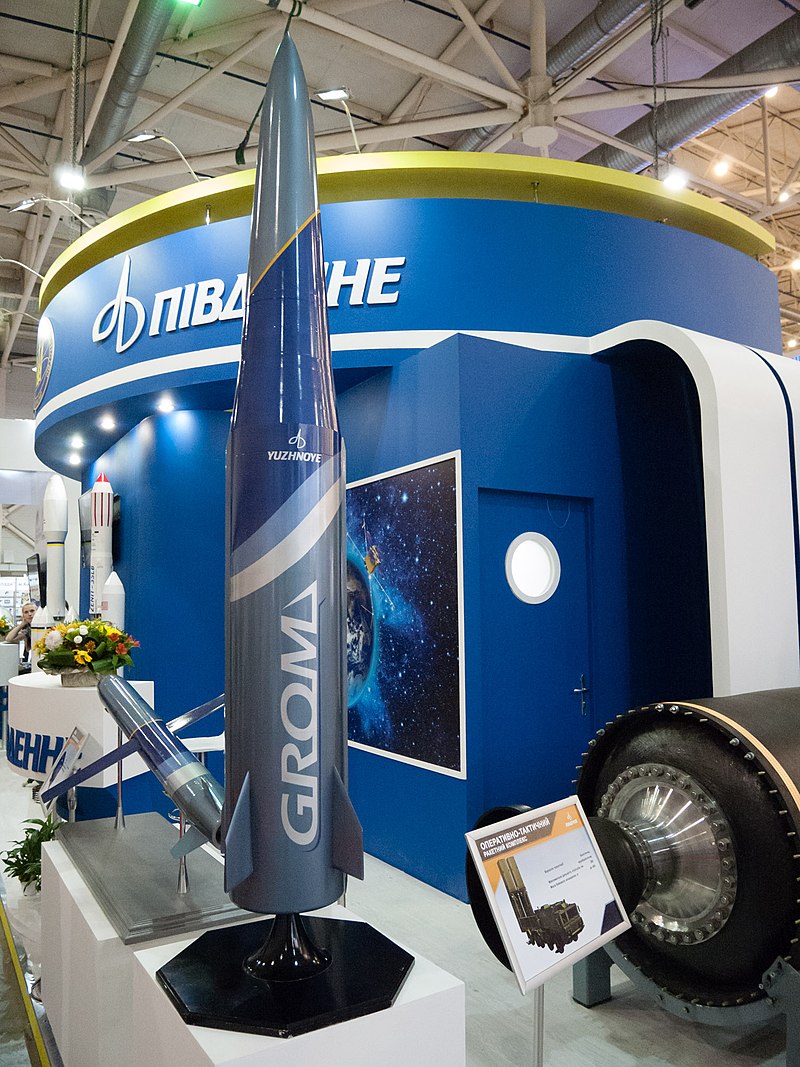In its April 19 report, the Russian Ministry of Defence (RuMoD) for the first time acknowledged the growing threat posed by Ukraine’s newly developed short-range ballistic missile, the Sapsan.
The RuMoD stated:
“Last evening, the Armed Forces of the Russian Federation delivered a group strike by land- and sea-based precision weaponry and unmanned aerial vehicles at a test site of the Ukrainian Sapsan operational-tactical missile system and Norwegian-made NASAMS air defence systems protecting it.
The goals of the strike were achieved. All assigned targets were destroyed.”
The Sapsan (also known as Grom-2) is a Ukrainian short-range ballistic missile system developed by KB Pivdenne and PA Pivdenmash. It is a single-stage, solid-fuel missile with a 500 kg warhead and an operational range estimated between 50 km and 400–500 km. Some reports suggest its maximum range could reach up to 700 km.
Sapsan combines characteristics of both a tactical missile and a multiple rocket launcher, resembling the U.S. ATACMS, which it is likely intended to replace.
Given that ATACMS is no longer in production and existing stocks are limited, further U.S. supplies to Ukraine are unlikely.
Moreover, recent U.S. statements suggest that without a clear movement toward peace from both sides, Washington may scale back its involvement, including weapons deliveries.

Sapsan Project
The Sapsan missile project was launched in 2006 by Ukraine’s National Security and Defense Council, with the goal of developing a modern, domestically produced ballistic missile system to replace the aging Soviet-era Tochka-U, then the only ballistic missile in Ukraine’s arsenal.
Progress on the project was slow due to financial constraints, and it was temporarily shelved in 2013. However, the onset of conflict with Russia in 2014 prompted its revival.
An export variant of the system, named Hrim-2, was developed with funding from Saudi Arabia. To comply with Missile Technology Control Regime (MTCR) limitations, the Hrim-2 was designed with a reduced range of 280 km.
Critical Missile Capabilities
The Sapsan missile is engineered to evade modern air defense systems such as Russia’s S-300 and S-400 by following an aeroballistic flight path, allowing it to alter its trajectory mid-flight and complicate interception.
It reportedly offers greater accuracy than the Russian Iskander, with a circular error probable (CEP) of approximately 20 meters, compared to the Iskander’s 30 meters. Additionally, Sapsan is more compact, weighing approximately 21 tons compared to the 42-ton Iskander.
Protracted Development
At the onset of the Russian Special Military Operation (SMO), the Sapsan missile was still under development.
On September 30, 2022, the Russian Aerospace Forces reportedly targeted and struck workshops involved in the assembly of Ukrainian Grom-2 and Tochka-U operational-tactical missiles at the Southern Machine-Building Plant near Dnipro (formerly Dnepropetrovsk).
Despite the strike, Ukraine continued to advance the development of the Sapsan missile program.
Operational Testing
According to the Russian Ministry of Defence (RuMoD), Ukraine has used the Grom-2 (Sapsan) short-range ballistic missile against targets in Russian territory, particularly Crimea, on several occasions since the start of the Special Military Operation (SMO).
Operational testing of the missile reportedly began around March 2023.
-
On March 30, 2023, Russian air defense systems intercepted one Grom-2 missile.
-
In April 2023, two Grom-2 missiles were intercepted.
-
Another two were reportedly intercepted in May 2023.
According to Rybar, a Russian think tank, on April 8, 2023, a Grom-2 missile launched from the Alibey/Tuzly training ground targeted Feodosia in Crimea. The missile reached an altitude of 15 km before being shot down by a Russian S-300 air defense system.
On October 1, 2023, at approximately 1:00 p.m. Moscow time, the RuMoD reported that Russian air defense systems thwarted an attempt by Ukrainian forces to strike with two Grom-2 missiles. The missile wreckage reportedly fell in the Dzhankoi region of Crimea.

Operational Pause
The Russian Ministry of Defence (RuMoD) did not report any Grom-2 missile strikes from October 2023 to November 2024, indicating a likely operational pause in the missile’s use.
This hiatus may have been due to technical shortcomings in the system, particularly issues related to trajectory control and targeting accuracy. Additionally, repeated Russian strikes on Sapsan development and testing facilities likely aimed to disrupt further refinement of the missile’s capabilities.
On September 7, 2024, Russian forces reportedly destroyed workshops producing Grom-2 components.
Later, on November 25 and 26, 2024, Iskander-M missile strikes neutralized two Grom-2 operational-tactical missile launchers.
These targeted attacks suggest a concerted Russian effort to delay or degrade the operational deployment of Ukraine’s indigenous missile system.

Project Maturity
On November 9, 2024, President Volodymyr Zelenskyy announced that Ukraine had produced its first 100 ballistic missiles, marking a significant milestone in the country’s domestic defense capabilities.
“Ukraine has successfully tested the first ballistic missile of its own production,” Zelenskyy stated.
While he did not name the system, it is widely believed he was referring to the Sapsan (also known as Grom-2)—Ukraine’s first indigenously developed ballistic missile. Prior to this, Ukraine’s ballistic missile inventory consisted of Soviet-era systems like the Tochka-U.
Zelenskyy emphasized Ukraine’s determination to scale up missile production to address ongoing national security threats, signaling that the Sapsan missile had likely reached a stage suitable for operational deployment.
Just two days later, on November 11, the Russian Ministry of Defence (RuMoD) reported a strike on a facility involved in Sapsan missile testing.
Further confirming its deployment, on November 25 and 26, Russian forces reportedly struck two Grom-2 missile launchers near Novomykhailivka in the Odessa region.
Conclusion
The Sapsan missile provides Ukraine with an independent long-range strike capability, thereby reducing its reliance on Western-supplied systems, such as ATACMS.
Unlike foreign systems, Sapsan can be continuously upgraded—including improvements in trajectory modulation and electronic warfare (EW) resilience—to adapt to evolving Russian air defense (AD) countermeasures.
Deployed at scale, Sapsan could pose a greater threat to Russian forces than ATACMS, particularly because Ukrainian targeting decisions would not be constrained by U.S. oversight.
This independence is likely a serious concern for the Russian leadership.
However, Ukraine’s ability to deploy Sapsan in large numbers could be limited by its reliance on Western-made components. If Ukraine fails to reach a negotiated settlement with Russia, particularly under pressure from a potential second Trump administration, it may lose access to these critical parts.
Similarly, ATACMS owes its effectiveness to targeting data provided by Western ISR (Intelligence, Surveillance, and Reconnaissance) assets. Should the U.S. reduce support, Ukraine might also lose access to this vital targeting infrastructure.
Whether using Sapsan or ATACMS, the strategic leverage currently lies with Washington. But for the Kremlin, counting on a U.S. policy shift remains a risky bet.
- Vijainder K Thakur is a retired IAF Jaguar pilot, author, software architect, entrepreneur, and military analyst.
- Follow the author @vkthakur




